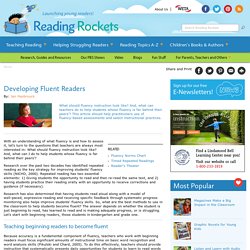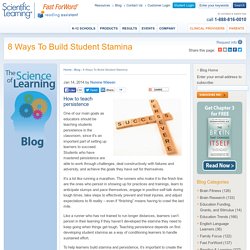

Edutopia. Useful Classroom Resources for Math Teachers. Developing Fluent Readers. With an understanding of what fluency is and how to assess it, let's turn to the questions that teachers are always most interested in: What should fluency instruction look like?

And, what can I do to help students whose fluency is far behind their peers'? Research over the past two decades has identified repeated reading as the key strategy for improving students' fluency skills (NICHD, 2000). Repeated reading has two essential elements: 1) Giving students the opportunity to read and then re-read the same text, and 2) having students practice their reading orally with an opportunity to receive corrections and guidance (if necessary).
Research has also determined that having students read aloud along with a model of well-paced, expressive reading and receiving specific feedback through systematic progress monitoring also helps improve students' fluency skills. Teaching Persistence: How to Build Student Stamina. One of our main goals as educators should be teaching students persistence in the classroom, since it's an important part of setting up learners to succeed.

Students who have mastered persistence are able to work through challenges, deal constructively with failures and adversity, and achieve the goals they have set for themselves. It’s a lot like running a marathon. The runners who make it to the finish line are the ones who persist in showing up for practices and trainings, learn to anticipate slumps and pace themselves, engage in positive self-talk during tough times, take steps to effectively prevent and treat injuries, and adjust expectations to fit reality – even if “finishing” means having to crawl the last mile. Like a runner who has not trained to run longer distances, learners can’t persist in their learning if they haven’t developed the stamina they need to keep going when things get tough. Help Learners Develop a Growth Mindset Model Persistence Teach Positive Self-Talk. How One Teacher Achieved Insane Reading Growth Last Year.
17 Ways to Meet Individual Learning Needs in the Math Classroom. Resources >> Browse Articles >> Utilizing Technology Featured Author: Mrs.

Kelly Tenkely Kelly Tenkely is a technology teacher in a private school. Kelly also trains teaching staff on integrating and implementing technology into the classroom. Teaching for all levels — in one class. In Elise Carter’s second-grade class, some students still write their numbers backward or look at their fingers to add.

Others race through multiplication tables or search the Web to teach themselves about negative numbers. She does her best to challenge all of them, dividing her class at Galway Elementary School in Silver Spring into thirds and customizing a series of rotating lessons for the students. Each group takes a turn at the teacher’s table at the sound of a little brass bell. Experts call it differentiated instruction — in essence, adapting lessons for kids of different abilities within a classroom. Teachers have always had to juggle disparate student needs. The practice of “tracking” students — isolating the high, average or low performers in different classrooms — is falling out of favor. “Each year, it seems like the expectations and the demands get a little bit higher,” Carter said. The 27-year-old teacher arrives at school each day two hours early.
Varied techniques local. Edutopia. Motivating students to be enthusiastically receptive is one of the most important aspects of mathematics instruction and a critical aspect of any curriculum. Effective teachers focus attention on the less interested students as well as the motivated ones. Here are nine techniques—based on intrinsic and extrinsic motivation—that can be used to motivate secondary school students in mathematics. Extrinsic and Intrinsic Motivation Extrinsic motivation involves rewards that occur outside the learner’s control. These may include token economic rewards for good performance, peer acceptance of good performance, avoidance of “punishment” by performing well, praise for good work, and so on.
However, many students demonstrate intrinsic motivation in their desire to understand a topic or concept (task-related), to outperform others (ego-related), or to impress others (social-related). Strategies for Increasing Student Motivation in Math 1. 2. 3. 4. 5. 6. 7. 8. Reading Plus Teacher Guide. 5 Steps to Significantly Increase Your Child’s Reading Level. As a teacher, I constantly had parents approaching me asking how they could help increase their child’s reading level.

Below I have 5 great steps you can take toward that goal. These are techniques I, and other good teachers who follow the latest research in children’s literacy, have incorporated into the classroom and found incredible results. I have adjusted the implementation so you can incorporate these techniques into your home seamlessly. Step 1: Determine your child’s “Just Right” Reading Level Research indicates that “fluency develops as a result of many opportunities to practice reading with a high degree of success.”1 Meaning, a child becomes a better reader by regularly reading books that are at their appropriate level. Likewise, books that are “too challenging”, significantly above their level, may lead the child to become frustrated, which is completely counter-productive.
There are a few ways. Sonlight Quick Reading Assessment – this is great for preK-4th grade readers.